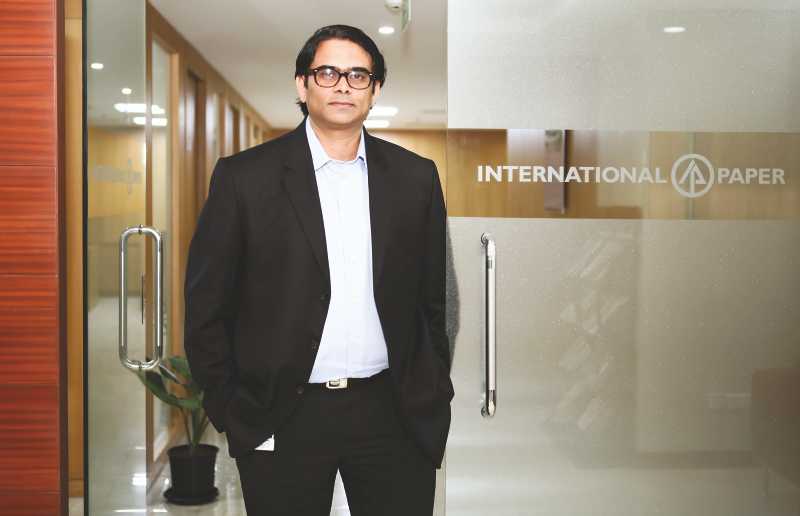International Paper believes in mobilizing its people, products, and resources to address critical needs in the communities where its employees live and work in order to create and sustain a gigantic pool of prolific workforce.

The company’s HR needs influence strategic planning, and more often leads to sudden, significant, and visible change in the overall business strategy. IP’s HR strategy is tuned to accommodate such sudden changes and usher the entire workforce to see the big picture rather than to toe the normative line even in the time of urgently new course of action. In this scenario, the guiding light is the ‘The IP Way’.
Mr. Mukund Menon, Director, HR & Communications, International Paper recently interacted with Paper Mart on a host of critical issues related to human resource management and its changing ways with the fast changing face of the manufacturing industry. During the interview, he expounded at length on the most significant changes he has noticed in the manufacturing industry and those HR strategies which got developed to address or accommodate those changes. Excerpts:
Paper Mart: International Paper is the world’s leading producer of pulp and paper with 55,000 employees operating in 24 countries. From human resource management and development view point, what does the company do to effectively manage this vast pool of human resources scattered around an extensive geography along with simultaneously ensuring the unified work ethic and objectives?

Mukund Menon: Actually, International Paper believes investing in people. We make sustainable investments to protect and improve the lives of our employees and mobilize our people, products, and resources to address critical needs in the communities where our employees live and work. When it comes to people, our core objective is safety. We share the objective of ensuring that every employee and those around them go home safely every day. Nothing we do is worth the risk of an injury to an employee, contractor or visitor. Our safety mantra is clear, which is- to follow all of the rules all of the time.
Further, we try to maintain the 3C’s – Character, Capability, and Catalyst, which have become a natural part of our leadership language and are well integrated into our people development tools and systems. Besides, we believe in ethical behavior and personal integrity which is our core culture. This is the ethical foundation that guides our work and our lives.
Lastly, I would like to say that diversity and inclusion are the driving forces that genuinely value our workforce. Diverse ideas result in a better work environment where diversity is valued and encouraged. This prompts a heightened level of collaboration and innovation that yields in a better business performance.
PM: Employees are any company’s greatest assets; what are the fundamentals on which International Paper work to create people/HR development tools and systems in order to form a robust, loyal, ethical, and productive work force?
MM: All IP employees globally follow one language and that is ‘The IP Way’. By IP way, we mean that we do the right things, in the right ways, for the right reasons. The IP way governs everything we do: from our vision to be among the most successful, sustainable and responsible companies in the world to our mission to improve people’s lives, the planet and our company’s performance by transforming renewable resources into products people depend on every day.
Our basic principles are to strengthen our people and the communities where we live and work, using all resources responsibly and efficiently and ensuring our businesses are safe, successful and sustainable for generations to come. Through The IP Way, we go beyond just doing the right things; it is how we create value for all stakeholders for generations to come by sustaining forests, investing in people, improving the planet, creating innovative products and delivering inspired performance.
PM: As the Director, HR of International Paper, do you think that the company’s HR needs influence strategic planning, and more often leads to sudden, significant, and visible change in the overall business strategy? Have you experienced such instances while working in the current capacity?
MM: It is very important that the people work closely with the CMD and CEO as a partner in key decisions that influence business and future growth. The strategic role is to understand the nuances of the business and challenges to enable seamlessly functioning of the company.
While operational excellence in managing some of the transactional functions is the minimum expectation, the larger need is to be the thought leader in the company. It is someone who could play a major role not only in HR, but also as a good advisor and conscious keeper of the company.
The key role of an HR is to change management, keep the pace of transformation, and maintain the company’s reputation and ethics. Overall making sure that the leadership is intact.
PM: What do you do to ensure the HR department’s objectives are aligned with strategic goals? Let’s assume you encounter a problem but there are no official guidelines for solving it. What would be your course of action?
MM: The functional goals and objectives for the HR are aligned every year to the top priorities for the business. If it is not aligned, it will lose its relevance. They are obviously to provide a broad direction to the function and the teams to ensure that all are pulling in the same direction. In real world, the things planned or written down on a piece of paper don’t materialize as conceived. At times it changes. It is important to be nimble and be able to respond to the situation.
Most of the time people reach out to the HR with an expectation to find a solution to their problems. In the same manner, the HR function should work as a solution provider and be agile enough to respond to demands of business that come across during the year. Most of the failures of HR function are that they focus mostly in operations and become transactional leaders. They fail to see the big picture and business dimension and become tied to process and policies.
At times, the situation will be something that it is new and not covered in the normal policies and guidelines in the company. During this situation, it is important that we apply the principles of IP Way, that we do the right things, in the right manner, for the right reasons, all the time. It is the ability to take the right decision in the right way.
PM: If you have to use three words to describe the role of an HR Director in a company, what would those be? Why? What KPI’s do you use to measure the effectiveness of the HR function?
MM: It is difficult to put the role of HR in three words but still I would say that an HR is a partner to the CMD or CEO. His role is to be the thought leader at the executive table, be the trusted advisor and help take decisions.
Over and above that, an HR should be an organizational steward or change manager and provide leadership in strengthening the organizational values of safety, ethics, integrity, trust and community. Also, an HR’s quality of being an executive coach to the leadership can drive engagement and high performance at the organization, team and individual levels.
Some of the key parameters to measure the health index are attrition, engagement index, operational excellence in transactional issues, leadership & talent bench, diversity and inclusion, early identified talent, first line leader growth and involvement, high potential identification and development.
PM: With the changing face of the manufacturing industry, HR practices have also undergone tremendous refashioning in order to suit the time. What are the most significant changes have you noticed in the manufacturing industry and what are those HR strategies which got developed to address or accommodate those changes?
MM: One of the good progress that is being made recently is that changes in rules and regulations and amendments that are being implemented by the new government. The labor legislations were made decades back and the landscape of employment have changed over a period of time.
The few positive changes that one can see are baby boomers exit from the system in couple of years. Then there will be a new infusion of talent at the bottom of the organization, millennial and young employees, who will bring different expectation, skills and capabilities to the table. It will be interesting to see how the new world will change with the new set of talent in the workforce.
Also, more and more contract workers are becoming relevant to the work. The world is moving towards treating them as good as full time employees and move away from the contingent nature of the work. Some of the contingency will stay and the jobs which are not in-core will continue.
The manufacturing world will become digital when it comes to people practices and tools. In today’s world most of them use smartphones to do their personal transactions. It cannot be any different when it comes to the company. The employees will expect.
The style of managing will move from being command and control to coaching and mentoring. There is going to be less tolerance to decisions being pushed and hierarchical approach of management. People will expect a lot of two way communications and an opportunity to be seen and heard.



